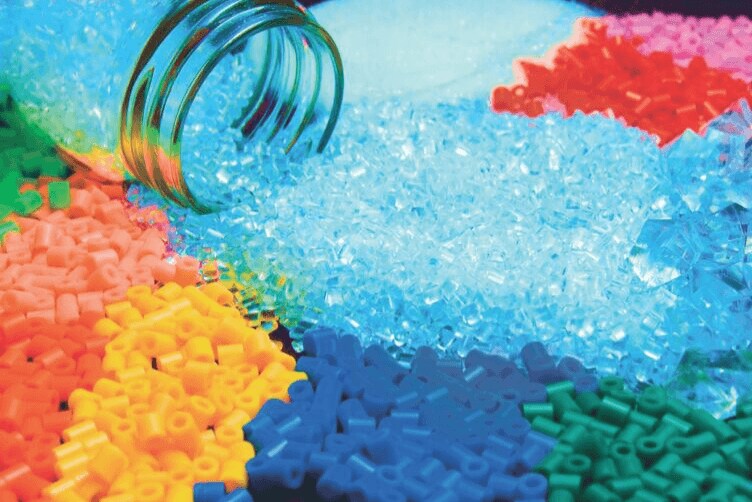What are polymers?
Polymers consist of large molecules that form a chain of single molecular units (monomers) derived from hydrocarbons. Polymers with more than one monomer type are called copolymers. Used in food packaging, building materials, 3D printing, toys, automotive parts, storage containers, and hundreds more consumer and industrial items, polymers are typically heated to a melting point and molded or extruded to a functional unit.

Polymers
Polymer structure
The basic structural properties of polymers play a major role in determining their physical properties and function, even when they are made up of the same monomers. An important microstructural feature of a polymer is its architecture and shape, which relates to the way branch points lead to molecules composed of a main chain with one or more substituent side chains or branches. A polymer’s architecture affects many of its physical properties such as solution viscosity, melt viscosity, solubility, glass transition temperature and the size of individual polymer coils in solution. The physical properties of a polymer strongly depend on its length of the polymer chain, which is the degree of polymerization, or simply the number of monomers incorporated into the chain, which can be expressed in terms of molecular weight.
Crystallization of polymers
Another factor that determines a polymer’s physical properties is its morphology, that is the alignment of the polymer chains. These chains fold together, and form ordered regions (plates), which are composed of larger spherical semicrystalline regions inside non-branched linear polymers called spherulites. Their formation is associated with crystallization of polymers as they cool from melting, mechanical stretching or solvent evaporation. As they solidify, polymers may retain their disordered amorphous structure, crystallize completely, or a fraction of molecules may align while the rest remain disordered to become semicrystalline. This affects optical, mechanical, thermal and chemical properties of the polymer, which can be measured as the degree of crystallization. Understanding this value is critical in the development, production and quality control of the polymer and any finished product.
Two of the most commonly used polymers are the thermoplastics polyethylene (PE) and polypropylene (PP).
Polyethylene
While many kinds of polyethylene are known, most are from the chemical formula (C2H4)n. PE is usually a mixture of similar polymers of ethylene (H2C=CH2) with various values of n. In addition to being a thermoplastic, polyethylene can become a thermoset plastic when modified (such as cross-linked polyethylene). PE is found across a range of densities that determine its usage.
High-density polyethylene (HDPE) has many applications, from 3D printer filament to piping for gas, fluids or slurries. Low-density polyethylene (LDPE) is chemically stable at room temperatures and therefore widely used for manufacturing various containers, bottles, tubing, plastic parts for computer components, and various molded laboratory equipment. Polyethylene terephthalate (PET) is used in clothing (polyester), containers for food and liquids, and in engineering resins. It is one of the most commonly recycled materials.
Polypropylene
Polypropylene is produced via chain-growth polymerization from the monomer propylene. It belongs to the group of polyolefins and is partially crystalline and non-polar. Its properties are similar to polyethylene, but it is slightly harder and more heat resistant. Many plastic items for medical or laboratory use are made from polypropylene because it can withstand the heat in an autoclave and is commercially found in “dishwasher safe” food containers. Because it is also highly resistant to fatigue, you will find it on many hinged materials. A commodity plastic with the lowest density, PP is the second most produced polymer after PE. Resistant to fat and organic solvents, it is frequently used in food packaging and storage containers. PP can be transparent, translucent or colored. Most commercial polypropylene is isotactic and has an intermediate level of crystallinity between that of low-density polyethylene (LDPE) and high-density polyethylene (HDPE).
XRD of polymer crystallization
The laboratory analytical technique X-ray diffraction (XRD) uses a beam of incident X-rays to diffract into a material in order to characterize its molecular ordering and is a gold-standard indicator of polymer crystallization. X-ray diffraction application specialists at Thermo Fisher Scientific used a benchtop X-ray diffractometer to analyze sheet samples of polyethylene and polypropylene to demonstrate the varying degree of crystallinity (D) between PE and PP samples.
Using an organic XRD database, specialists were able to determine both the type and the crystallinity of polymer materials. The values ranged from high (PE 1) and low (PE 2) density PE and isotactic (α-) PP. In less than 10 minutes it is possible to determine the quality of polymer materials in research labs, as well as during the production process, enabling manufacturers to reduce the cost and improve the quality of polymer products.
Want to speak to someone? Need a quote? Want a demo? |
Opt in for email communications on this and other topics. |
Leave a Reply